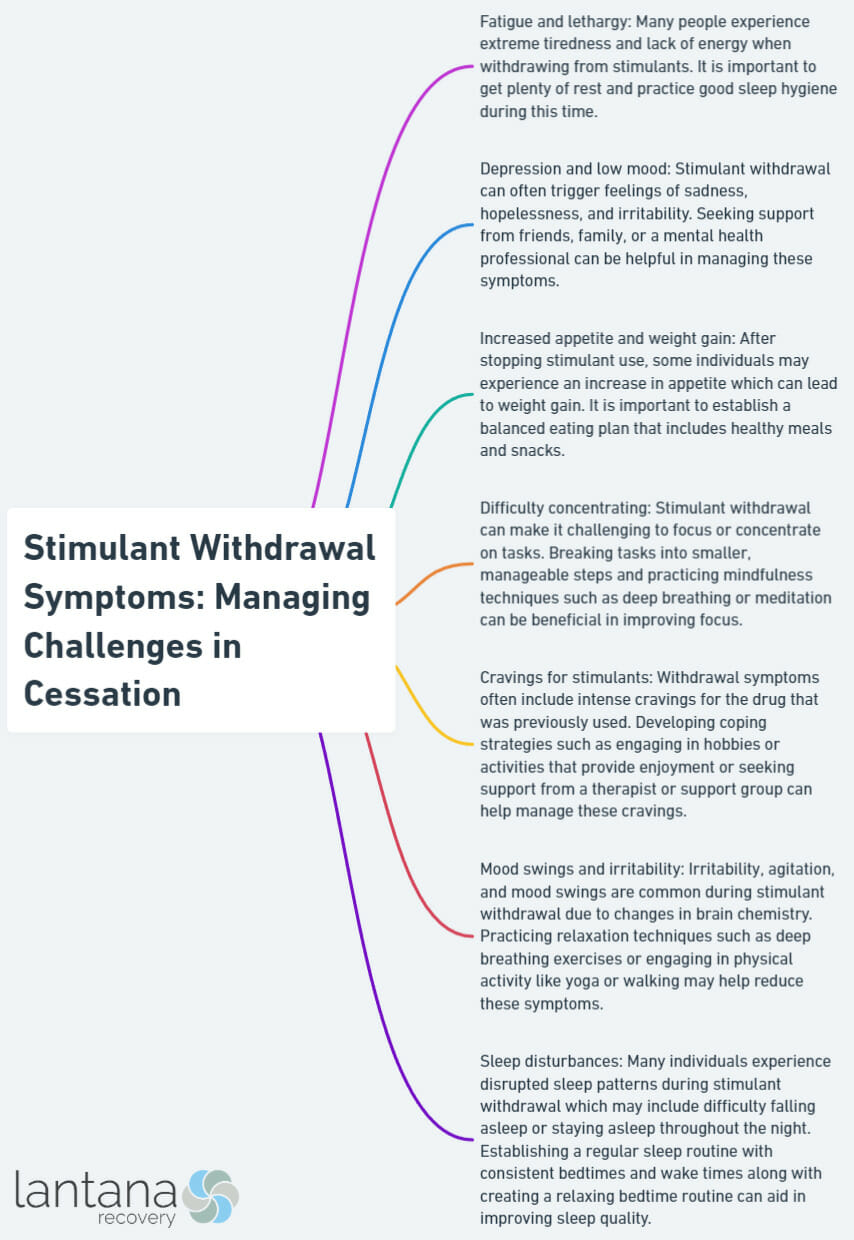Stimulant withdrawal can be challenging and uncomfortable, but with the right strategies and support, it is possible to overcome these difficulties. Understanding stimulant withdrawal, common stimulant drugs and their withdrawal symptoms, and how to manage these symptoms are crucial steps in the cessation process. In this article, we will explore the different aspects of stimulant withdrawal and provide insights on managing the challenges that arise.
To begin, let’s delve into the concept of stimulant withdrawal. Stimulant drugs, such as cocaine, amphetamines, and prescription stimulants, stimulate the central nervous system and can lead to dependence with prolonged use. When a person decides to stop using these substances, they may experience a range of withdrawal symptoms that can be both physical and psychological in nature.
Next, we will examine the specific withdrawal symptoms associated with different stimulant drugs. Cocaine withdrawal symptoms may include fatigue, depression, and intense cravings. Amphetamine withdrawal symptoms may manifest as irritability, increased appetite, and low energy. Prescription stimulant withdrawal symptoms can vary but may involve depression, anxiety, and difficulty concentrating.
Managing stimulant withdrawal symptoms is essential for a successful cessation journey. Strategies such as medical supervision, gradual tapering, incorporating supportive therapies like counseling or support groups, and adopting healthy lifestyle habits can all contribute to a smoother transition.
We will explore the challenges that individuals may encounter during the cessation process and provide advice on how to overcome them. Cravings and triggers, emotional and psychological challenges, and physical and mental fatigue are common hurdles experienced during stimulant withdrawal. Developing coping mechanisms, seeking support from loved ones, engaging in stress-reducing activities, and practicing self-care can all assist in overcoming these challenges.
Lastly, we will emphasize the importance of seeking professional help during the stimulant withdrawal process. Consulting with a healthcare professional or addiction specialist can provide personalized guidance, support, and treatment options tailored to an individual’s specific needs.
By understanding stimulant withdrawal, effectively managing symptoms, overcoming challenges, and seeking professional help, individuals can navigate the cessation process with greater ease and increase their chances of attaining long-term recovery.

Understanding Stimulant Withdrawal
Understanding stimulant withdrawal is vital for effectively managing the challenges of stopping or reducing the use of substances like amphetamines, cocaine, and methamphetamine.
Withdrawal symptoms, which may include fatigue, depression, anxiety, irritability, and increased appetite, can vary in intensity and duration.
The seriousness of these symptoms can be influenced by factors such as the duration and intensity of stimulant use, individual differences, and the presence of other conditions.
While not life-threatening, stimulant withdrawal can be extremely uncomfortable and emotionally difficult.
It is crucial to seek support from healthcare professionals, such as addiction specialists or therapists, in order to comprehend and address these symptoms.
Collaborating with a healthcare provider to develop a personalized withdrawal plan ensures a safer and more successful cessation process.
Coping strategies may involve gradually reducing the dosage, engaging in healthy coping mechanisms such as exercise or relaxation, and addressing underlying mental health issues.
Support from loved ones, family, and support groups also plays a crucial role in providing encouragement and accountability during the withdrawal phase.
It is important to remember that recovery is a journey, and comprehending stimulant withdrawal is the initial step towards a healthier and more fulfilling life.

Common Stimulant Drugs and Their Withdrawal Symptoms
Kickstarting the exploration into stimulant withdrawal symptoms, we dive into the world of common stimulant drugs and their associated challenges when quitting. Get ready to uncover the distinct withdrawal symptoms linked to cocaine, amphetamines, and prescription stimulants. From the highs and lows of these substances to the hurdles faced during cessation, this section unveils the intricate web of effects that stimulant drugs can have on the body and mind. Brace yourself for a deep dive into the world of withdrawal.

Cocaine
Cocaine is a powerful stimulant derived from the coca plant. It quickly enters the bloodstream and produces a euphoric high. However, its effects are short-lived, leading to a crash and intense cravings. Withdrawal symptoms can be severe and include fatigue, depression, anxiety, and intense cravings.
Medical supervision is necessary to manage cocaine withdrawal, suggests Shorter and Kosten from Baylor College of Medicine, Houston in their research Novel pharmacotherapeutic treatments for cocaine addiction. Gradual tapering off the drug may be recommended to minimize symptoms. Supportive therapies, such as counseling and behavioral therapies, can help individuals cope with the challenges of withdrawal. Adopting healthy lifestyle habits can support the recovery process.
Amphetamines
Amphetamines are drugs that stimulate the central nervous system and are used to treat ADHD and narcolepsy. Withdrawal symptoms from amphetamines can vary in severity and duration, including fatigue, depression, irritability, and increased appetite. Medical supervision is crucial during amphetamine withdrawal to provide support, monitor progress, and address complications. Gradual tapering is often recommended to manage withdrawal symptoms by reducing dosage over time.
Supportive therapies like counseling and behavioral therapies can help address reasons for amphetamine use and develop coping strategies. Adopting healthy lifestyle habits, such as regular exercise, nutritious diet, stress-reducing techniques, and adequate sleep, can aid in managing amphetamine withdrawal. Overcoming the challenges of amphetamine cessation requires a strong support system, avoidance of triggers and high-risk situations, and seeking professional help if necessary.
Throughout history, amphetamines have been used for various purposes. They were initially developed in the early 20th century and gained popularity during World War II as a way to keep soldiers awake and alert. Over the subsequent decades, amphetamines were widely prescribed for appetite suppression and treating medical conditions. However, their addictive properties became apparent, leading to the need for effective withdrawal management strategies.
Prescription Stimulants
Prescription stimulants are commonly used for ADHD and narcolepsy. They improve focus, attention, and reduce hyperactivity. It’s important to be aware of the potential side effects and withdrawal symptoms associated with prescription stimulants. The table provided below offers information on different prescription stimulants and their main uses, as well as the withdrawal symptoms that may occur:
| Prescription Stimulant | Main Use | Withdrawal Symptoms |
|---|---|---|
| Adderall | ADHD and narcolepsy | Fatigue, depression, irritability, increased appetite |
| Ritalin | ADHD and narcolepsy | Mood swings, anxiety, sleep disturbances, cravings |
| Vyvanse | ADHD and binge-eating disorder | Low energy, difficulty concentrating, disrupted sleep patterns |
Withdrawal symptoms can vary depending on the individual and usage of prescription stimulants. To avoid uncomfortable withdrawal symptoms, it is recommended to gradually taper off under medical supervision. If you are experiencing difficulties with prescription stimulant withdrawal, seeking professional help is important. Healthcare providers can provide guidance, support, and alternative treatments for managing ADHD symptoms. It is essential to remember that each journey is unique, and professional support can make a significant difference.

Managing Stimulant Withdrawal Symptoms
Feeling overwhelmed by stimulant withdrawal symptoms? Don’t worry, in this section, we’ll explore effective strategies for managing these challenges. From medical supervision to gradual tapering, supportive therapies, and adopting healthy lifestyle habits, we’ve got you covered. So, let’s dive in and discover the best ways to navigate through the hurdles of stimulant withdrawal and regain control of your well-being.
Medical Supervision
Medical supervision is absolutely crucial when it comes to managing symptoms of stimulant withdrawal. It is under the careful guidance of medical professionals that individuals can receive the personalized care and support that is tailored to their specific needs. Through regular check-ups and evaluations, healthcare providers are able to closely monitor progress, identify any potential complications, and make necessary adjustments to the treatment plan.
“Clinical studies have shown promise for adrenergic blockers, such as disulfiram and lofexidine, as treatments for cocaine abuse and dependence, especially in patients experiencing severe withdrawal symptoms,” suggests a research review published in Addiction Biology. (REVIEW: Norepinephrine and stimulant addiction, Sofuoglu, Sewell, 2009)
Additionally, medical supervision plays a pivotal role in helping individuals navigate the physical and mental challenges that come with withdrawal, utilizing medications and therapies as necessary. It is important to supplement this medical supervision with strategies such as gradual tapering, supportive therapies, and the adoption of healthy lifestyle habits. By taking a comprehensive approach that combines both medical supervision and interventions, individuals have the best chance of achieving a successful recovery from stimulant addiction. Therefore, it is strongly advised to seek out medical supervision and professional help to ensure a safe and effective recovery process.
Gradual Tapering
Gradual tapering is an essential component in effectively managing withdrawal symptoms associated with stimulant use. The process involves gradually reducing the dosage of the stimulant drug over a period of time, allowing the body to adapt to the decreasing levels of the substance. This gradual tapering allows for a smoother adjustment, significantly minimizing withdrawal symptoms.
To ensure safety and efficacy, medical supervision is necessary throughout the gradual tapering process. Experienced medical professionals provide guidance, monitor progress, and make any necessary adjustments. They determine an appropriate tapering schedule based on various factors, including the specific stimulant drug used, the duration and dosage of use, and the individual’s overall health.
During the gradual tapering process, individuals should be prepared for potential challenges. Cravings and triggers may tempt individuals to return to drug use. Additionally, emotional and psychological challenges such as anxiety or depression may arise. It is common for individuals to experience physical and mental fatigue as the body adjusts to lower levels of the stimulant.
To support individuals during the gradual tapering process, counseling or participation in support groups can be beneficial in addressing emotional and psychological challenges. It is also important for individuals to adopt healthy lifestyle habits, including regular exercise, sufficient sleep, and a balanced diet, as these factors can help manage withdrawal symptoms effectively.
Supportive Therapies
Supportive therapies, such as cognitive-behavioral therapy (CBT), motivational interviewing (MI), group therapy, and family therapy, are essential in managing stimulant withdrawal symptoms. These therapies enhance well-being and overall success during this challenging process.
CBT is one effective treatment that helps individuals identify and change negative thinking patterns and behaviors that contribute to substance use or behavioral addictions like sexual addiction . It also assists in developing coping strategies and stress management techniques. By cultivating healthier thoughts and behaviors, individuals can navigate withdrawal challenges and reduce the risk of relapse.
MI is another valuable therapy that encourages individuals to explore their motivations for change. It enhances intrinsic motivation to quit stimulant use and empowers individuals to set achievable goals. Through MI, individuals develop a sense of autonomy and self-efficacy, which is vital in overcoming withdrawal challenges.
Group therapy provides camaraderie and support, allowing individuals to share experiences and listen to others going through similar struggles. This type of therapy fosters accountability and provides a platform for learning from each other’s successes and setbacks.
Family therapy involves the support and involvement of loved ones. It addresses dysfunctional family dynamics that may have contributed to substance use and strengthens the support system. Additionally, family therapy educates family members on effective support during withdrawal.
Incorporating these supportive therapies into the management of stimulant withdrawal symptoms can greatly enhance the overall experience and increase the chances of successful recovery.
Healthy Lifestyle Habits
Incorporating healthy lifestyle habits can be beneficial in managing stimulant withdrawal symptoms. Here are some healthy habits that can help during the withdrawal process:
- Regularly engage in exercise: Engaging in regular physical activity boosts overall well-being and alleviates withdrawal symptoms. Aim for at least 150 minutes of moderate-intensity aerobic activity or 75 minutes of vigorous-intensity aerobic activity each week.
- Prioritize getting enough sleep: Adequate sleep is crucial for recovery. Establishing a consistent sleep schedule and creating a relaxing bedtime routine can promote quality sleep.
- Nourish your body with a balanced diet: Proper nutrition is essential for healing and regaining strength. Make sure to include a variety of fruits, vegetables, whole grains, and lean proteins in your diet.
- Stay hydrated: Drinking plenty of water is important for overall health and detoxification. Aim to drink at least 8 glasses per day.
- Effectively manage stress: Find healthy ways to cope with stress, such as practicing relaxation techniques, pursuing hobbies, or seeking support from loved ones.
- Avoid triggers: Be proactive in identifying and avoiding situations, people, or places that may lead to cravings or temptations to use stimulants.
- Seek support: Surround yourself with a strong support system of friends, family, or support groups who can provide encouragement and assistance throughout the withdrawal process.
Remember, incorporating these healthy habits, along with other treatment strategies, enhances the recovery process and improves overall well-being. It is always advisable to consult healthcare professionals for personalized guidance and support during stimulant withdrawal.

Photo Credits: Www.Lantanarecovery.Com by Jordan Anderson
Challenges in Cessation and How to Overcome Them
Overcoming the challenges of stimulant withdrawal can be a tough journey, but it’s not impossible. In this section, we’ll dive into the different obstacles you might face when trying to quit and share strategies to help you conquer them. We’ll explore the battle against cravings and triggers, navigate through emotional and psychological challenges, and find ways to cope with the physical and mental fatigue that withdrawal can bring. So, let’s arm ourselves with knowledge and resilience as we tackle these hurdles head-on.
Cravings and Triggers
Managing cravings and triggers is crucial for successful cessation of stimulant withdrawal. Understanding and addressing these cravings and triggers factors can significantly enhance the chances of overcoming addiction. Here are some important points to consider:
- Identify cravings and triggers: Recognize the specific circumstances, people, or emotions that lead to cravings and triggers. Develop strategies to avoid or cope with them. Common cravings and triggers may include stress, social situations, or places associated with drug use.
- Build a support network: Surround yourself with a strong support system, such as friends, family, or a support group. They can provide encouragement, accountability, and guidance when facing triggering situations.
- Develop coping mechanisms: Find healthy ways to cope with cravings and triggers. Engage in activities like exercise, meditation, or hobbies to redirect your focus and alleviate stress. Learning relaxation techniques or seeking therapy can also be beneficial.
- Avoid temptation: Minimize exposure to environments or individuals that may tempt you to use stimulants. Remove any substances or paraphernalia from your surroundings to eliminate cravings and triggers and reduce the likelihood of relapse.
- Take care of your well-being: Prioritize self-care and maintain a healthy lifestyle. Get enough rest, eat nutritious meals, and engage in regular physical activity. These habits can boost your overall well-being and make it easier to resist cravings and triggers.
- Consider professional help: If you struggle to manage cravings and triggers on your own, seeking professional help is essential. Addiction specialists can provide personalized strategies and therapies to support your recovery.
Remember, overcoming addiction is a challenging process. But with determination, support, and effective coping mechanisms, you can manage cravings and triggers to achieve long-term sobriety.
Emotional and Psychological Challenges
Emotional and psychological challenges are prevalent throughout the process of stimulant withdrawal. However, individuals can effectively navigate these challenges through the implementation of appropriate support systems and coping strategies.
- Intense drug cravings often become a significant emotional barrier during withdrawal. By incorporating mindfulness techniques or employing distraction strategies, individuals can effectively manage and overcome these cravings.
- Mood swings are another common emotional hurdle experienced during withdrawal. Engaging in activities that promote relaxation and overall well-being, such as exercise or meditation, can greatly contribute to emotional regulation.
- Stimulant withdrawal may lead to difficulties with concentration and memory. To alleviate these cognitive challenges, individuals can implement structured schedules and seek support from their loved ones.
- Environmental and social factors can serve as triggers for cravings and social pressures during withdrawal. Identifying these triggers and developing a personalized plan to avoid or manage them is a vital aspect of achieving successful recovery.
It is crucial to remember that seeking professional help and support is pivotal in managing emotional and psychological challenges during stimulant withdrawal. Mental health professionals can offer guidance, therapy, and medication, if deemed necessary, to facilitate long-term recovery.
A study published in the journal Drug and Alcohol Dependence revealed that cocaine addicts reported a higher difficulty in managing emotions in the earlier stages of withdrawal. That is why it is crucial to seek professional help for your mental and emotional health during cocaine detox.
Physical and Mental Fatigue
During stimulant withdrawal, individuals may experience both physical and mental fatigue. It is essential to address and effectively support the recovery process by acknowledging this symptom.
Physical and mental fatigue can pose challenges to daily activities. To effectively manage these symptoms, it is crucial to prioritize self-care and adopt healthy lifestyle habits. Engaging in regular exercise can significantly enhance energy levels and combat fatigue. Activities such as walking, yoga, or swimming can greatly contribute to improving physical and mental well-being.
In addition to exercise, maintaining a balanced diet plays a vital role in combating physical and mental fatigue. Ensuring that one consumes nutritious foods, which are rich in essential vitamins and minerals, can replenish energy levels and address fatigue. Including foods high in iron content, such as leafy greens and lean meats, is advisable as iron deficiency can contribute to feelings of fatigue.
Adequate sleep is also paramount in managing physical and mental fatigue. Establishing a consistent sleep schedule and creating a relaxing bedtime routine can promote better sleep quality, ultimately combating fatigue. It is recommended to aim for 7-9 hours of sleep each night.
Furthermore, supportive therapies like counseling or therapy can offer coping mechanisms and tools to effectively manage the physical and mental challenges associated with withdrawal.
Delve into this insightful article that explores the dynamics of withdrawing from a person, shedding light on the transformative journey of emotional independence.

The Importance of Seeking Professional Help
Seeking professional help is of utmost importance when it comes to managing stimulant withdrawal symptoms. Professionals offer crucial guidance, medical supervision, emotional support, relapse prevention strategies, and a faster recovery process.
- Guidance from professionals is invaluable as they possess the expertise and knowledge necessary to create personalized plans that effectively manage symptoms and minimize discomfort.
- Medical supervision provided by professionals is essential in closely monitoring your condition to prevent complications. They can also prescribe medication if needed to alleviate symptoms and assist with detoxification.
- Professionals understand the psychological aspects of withdrawal and provide counseling and emotional support to help you cope. They can also connect you with support groups and resources to further aid in your recovery.
- Relapse prevention is a key focus when working with professionals. They develop strategies to identify triggers and provide coping mechanisms for long-term sobriety.
Seeking professional help ensures a faster and safer recovery process. Professionals are equipped to handle any complications that may arise and can adjust treatment plans accordingly for a successful and sustainable recovery.
Frequently Asked Questions
1. What are stimulant withdrawal symptoms and how do they vary?
Stimulant withdrawal symptoms can include fatigue, depression, and strong cravings. However, the specific symptoms can vary depending on factors such as the type of stimulant used, the duration and intensity of use, and individual differences in metabolism and tolerance.
2. How long does the stimulant withdrawal period typically last?
The duration of the stimulant withdrawal period varies, but symptoms usually appear within a few hours to several days after the last use and peak about a week in. However, some psychological symptoms, like depression, can last for weeks or even months after quitting.
3. Is it necessary to seek professional medical help for stimulant withdrawal?
Yes, it is strongly advised to seek professional medical help when quitting stimulants. Stimulant withdrawal can be intense and symptoms can lead to relapse if not managed properly. Medical detox, under the supervision of licensed physicians, can help make the withdrawal process more comfortable and safer.
4. What are the risk factors for stimulant addiction?
The causes and risk factors for stimulant addiction are believed to be a combination of genetic, environmental, and psychological factors. Genetic factors, environmental factors such as family beliefs and attitudes towards drug use, and peer pressure can all contribute to stimulant abuse. Other risk factors include being male, having a mental health disorder, lack of family involvement, loneliness, and peer pressure.
5. Can stimulant withdrawal result in serious side effects?
While stimulant withdrawal is usually not life-threatening, it can lead to serious side effects if not properly managed. These side effects can include dysphoric mood, cognitive symptoms, physiological changes, and neurological changes. Seeking professional medical help can help minimize the risks associated with stimulant withdrawal.
6. What is the role of post-acute withdrawal symptoms (PAWS) in stimulant addiction?
Post-acute withdrawal symptoms (PAWS) can occur for chronic users and may last longer than the initial withdrawal period. PAWS can include symptoms such as poor sleep, anxiety, depression, irritability, fatigue, and mood swings. However, these symptoms generally decrease in severity over time, with PAWS typically lasting from 12 to 18 months.









